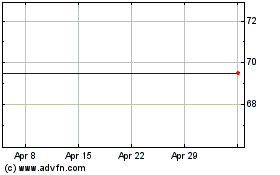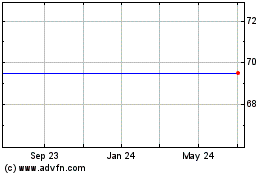Ball Aerospace Delivers Imaging Instrument for NASA's Mission to Pluto
April 11 2005 - 5:38PM
PR Newswire (US)
Ball Aerospace Delivers Imaging Instrument for NASA's Mission to
Pluto BOULDER, Colo., April 11 /PRNewswire-FirstCall/ -- Ball
Aerospace & Technologies Corp. has delivered a high-resolution
visible and infrared digital imager/spectrometer to the Southwest
Research Institute (SWRI) and its partner The Johns Hopkins
University Applied Physics Laboratory (APL) for flight aboard
NASA's proposed New Horizons Pluto-Kuiper Belt mission. Code-named
Ralph, the instrument is designed to collect high resolution black
and white and color images, and surface composition and temperature
maps of Pluto, its moon Charon, and images of celestial bodies deep
in the Kuiper Belt, far beyond Pluto's orbit. NASA's Marshall Space
Flight Center manages NASA's New Frontiers Program, which includes
the Pluto-Kuiper Belt mission. Johns Hopkins University's Applied
Physics Laboratory (JHU/APL) is implementing the mission. Dr. Alan
Stern of the Southwest Research Institute (SWRI), is the mission's
principal investigator. According to President and CEO David
Taylor, "Ralph is a critical instrument for the success of the New
Horizons mission and a milestone for our company, since it will go
deeper into space than any previous spacecraft or instrument built
by Ball Aerospace." As part of the New Horizons mission to Pluto,
Ralph is one of seven instruments that will enable scientists to
better understand the last unexplored planet at the edge of our
solar system. According to Dr. Stern, "Ralph is the centerpiece of
the New Horizons payload and it will revolutionize what we know
about Pluto, Charon, and Kuiper Belt objects." Because of Pluto's
great distance from the Sun -- 32 times farther than Earth's --
Ralph's digital imaging capabilities are designed to obtain data at
light levels 1,000 times more faint than daylight on Earth. Small
but robust, Ralph weighs only 24 pounds, and draws less than seven
watts of electricity when operating, or just enough to run a
household nightlight. The New Horizons mission is scheduled to
launch in January 2006. As a warm-up to Pluto, the spacecraft will
also conduct new surveys of Jupiter on its path to the outer
reaches of the solar system. The mission is expected to intercept
the distant Pluto and Charon in July 2015. After this rendezvous,
the spacecraft will then fly deep into the Kuiper Belt, an
extensive billion-mile-wide body of miniature planets, comets and
debris believed to have been formed at the genesis of the solar
system. Ball Corporation (NYSE:BLL) is a supplier of high-quality
metal and plastic packaging products to the beverage and food
industries. The company also owns Ball Aerospace & Technologies
Corp., which develops sensors, spacecraft, systems and components
for government and commercial markets. Ball employs more than
13,200 people worldwide and reported 2004 sales of $5.4 billion.
The company is celebrating its 125th year in 2005. Forward-Looking
Statements The information in this news release contains
"forward-looking" statements and other statements concerning future
events and financial performance. Words such as "expects,"
"anticipates," "estimates," and variations of same and similar
expressions are intended to identify forward-looking statements.
Forward-looking statements are subject to risks and uncertainties
which could cause actual results to differ materially from those
expressed or implied. The company undertakes no obligation to
publicly update or revise any forward-looking statements, whether
as a result of new information, future events or otherwise. Key
risks and uncertainties are summarized in the company's filings
with the Securities and Exchange Commission, especially in Exhibit
99.2 in the most recent Form 10-K. These filings are available at
our Web site and at http://www.sec.gov/. Factors that might affect
our packaging segments include fluctuation in consumer and customer
demand; availability and cost of raw materials, particularly the
recent significant increases in resin, steel, aluminum and energy
costs, and the ability to pass such increases on to customers;
competitive packaging availability, pricing and substitution;
changes in climate and weather; fruit, vegetable and fishing
yields; industry productive capacity and competitive activity; lack
of productivity improvement or production cost reductions; the
German mandatory deposit or other restrictive packaging laws;
changes in major customer or supplier contracts or loss of a major
customer or supplier; international business risks, including
foreign exchange rates, tax rates and activities of foreign
subsidiaries; and the effect of LIFO accounting on earnings.
Factors that might affect aerospace segment include: funding,
authorization and availability of government contracts and the
nature and continuation of those contracts; and technical
uncertainty associated with segment contracts. Factors that could
affect the company as a whole include those listed plus:
acquisitions, joint ventures or divestitures; regulatory action or
laws including environmental and workplace safety; governmental
investigations; goodwill impairment; antitrust and other
litigation; strikes; boycotts; increases in employee benefits and
labor costs; rates of return projected and earned on assets of the
company's defined benefit retirement plans; reduced cash flow;
interest rates affecting our debt; and changes to unaudited results
due to statutory audits or management's evaluation of the company's
internal control over financial reporting. DATASOURCE: Ball
Aerospace & Technologies Corp. CONTACT: David Beachley of Ball
Aerospace & Technologies Corp., +1-303-533-5089, Web site:
http://www.ballaerospace.com/
Copyright
Ball (NYSE:BLL)
Historical Stock Chart
From Jun 2024 to Jul 2024

Ball (NYSE:BLL)
Historical Stock Chart
From Jul 2023 to Jul 2024
